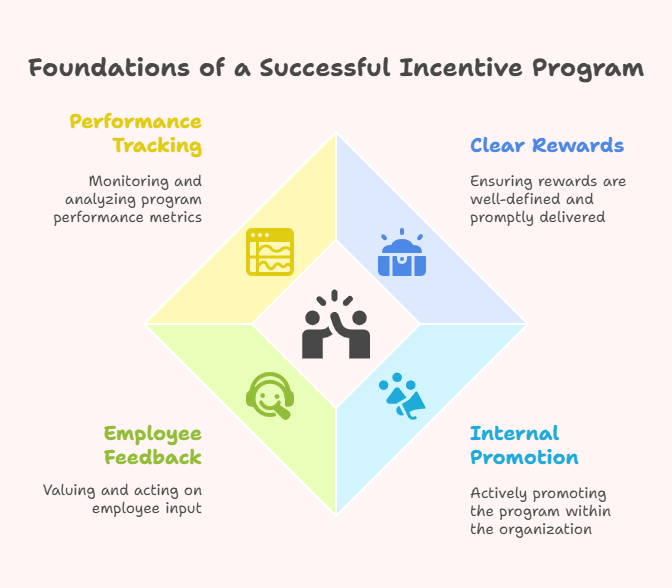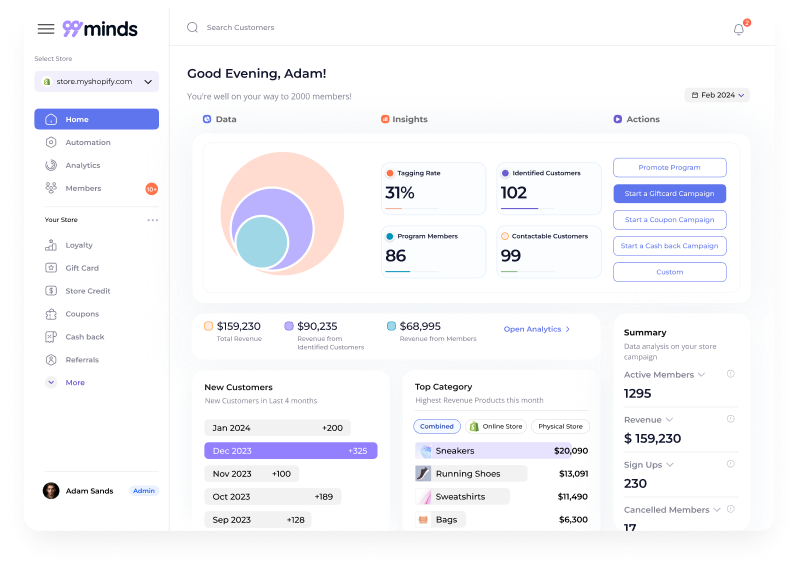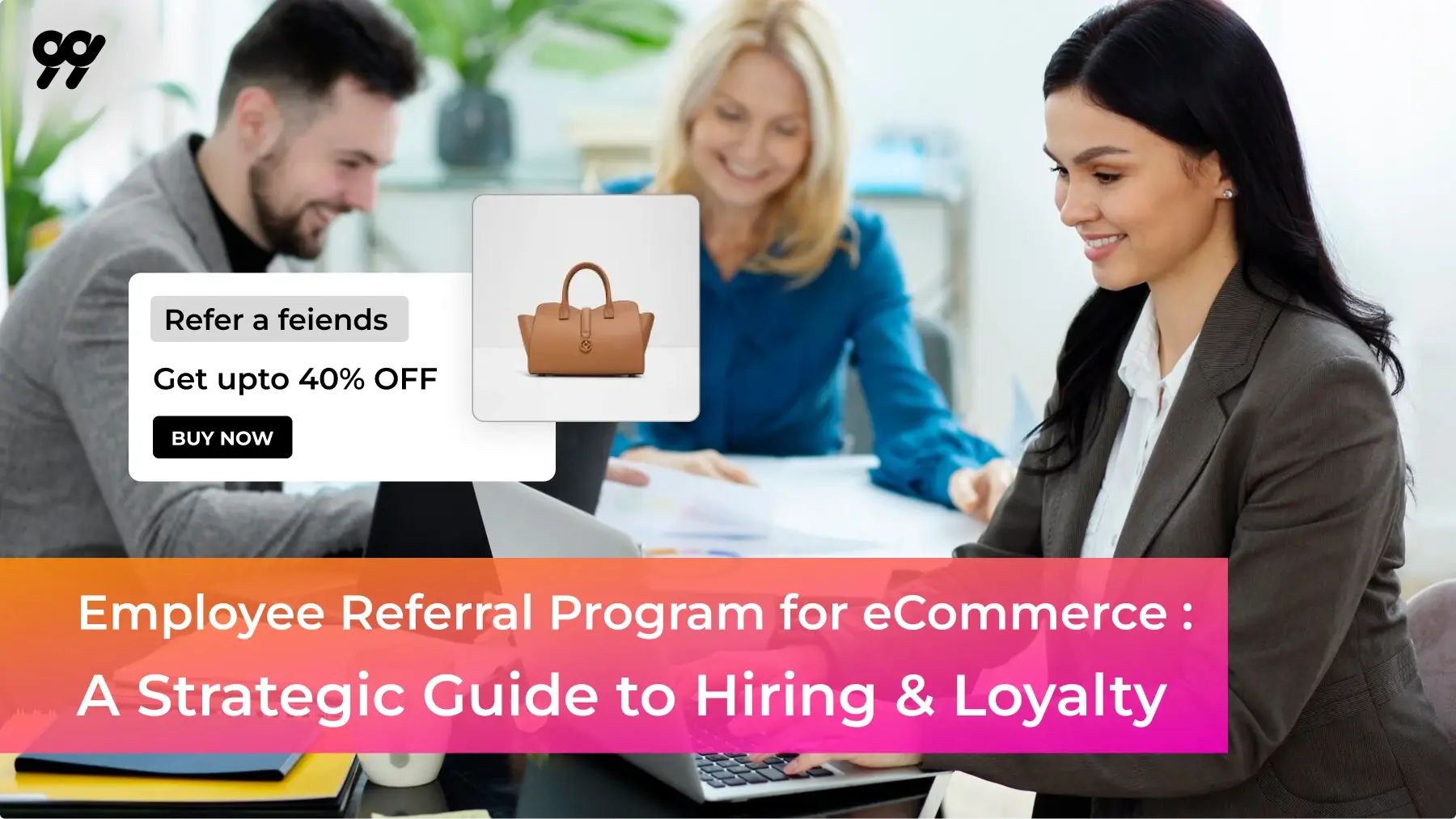
In the fast-paced world of eCommerce, building a strong and loyal team can be a game-changer. As customer expectations rise and competition grows, having top-tier employees who align with your brand values becomes critical. One of the most effective — and often underused — hiring strategies is the employee referral program.
Think of it as a loyalty program, but for your workforce. When employees are encouraged and rewarded for referring top talent, you’re not just filling roles — you’re building a culture of trust, advocacy, and long-term retention.
- Connect with customers on a deeper emotional level.
- Increase brand loyalty and trust.
- Turn one-time buyers into lifelong advocates.
In this blog, we’ll explore 15 powerful customer engagement strategies to help you build stronger relationships, improve retention, and ultimately boost your bottom line.
What is and Employee Referral Program?
An employee referral program is a structured system where current employees recommend candidates for open roles in your company. If their referral is hired and remains employed for a specified period, the referring employee typically receives a reward — which could be monetary, perks, recognition, or exclusive loyalty benefits.
This strategy leverages the networks of your team and helps attract candidates who already understand your company culture through your existing staff.
Benefits of an Employee Referral Program for eCommerce Businesses
Within the fast-paced world of eCommerce, enlisting the correct ability productively can make or break your development energy. That’s where representative referral programs step in—not reasonable as a selection device, but as a key exchange asset. Let’s break down why contributing in a referral program may be a smart move for each eCommerce brand:
- Faster Hiring Process
Time is money in eCommerce—especially when you're scaling fast or trying to fill critical roles during peak seasons. Referred candidates typically move through the hiring process 55% faster than those from traditional sources.
Why?
- Referred candidates usually come with a pre-vetted background, since your existing employees already know their capabilities and work ethic.
- There’s often a higher level of trust and less need for extensive screening.
- The rapport built through the referrer can eliminate delays in scheduling interviews or following up.
Real-life scenario: Imagine your warehouse needs a fulfillment manager before Black Friday. With a referral, you could have someone in place in a week instead of waiting a month through job boards.
- Better Employee Retention
Here’s a stat to chew on: Referred employees have a 45% retention rate after two years, compared to only 20% from job boards.
Why do they stay longer?
- They walk in with realistic expectations because their referrer gives them the inside scoop.
- They're already aligned with the company vibe and culture.
- There’s a sense of accountability (and pride) because someone they know vouched for them.
For eCommerce brands that deal with seasonal hires, logistics staff, or customer service reps—where turnover can be high—this kind of built-in loyalty is golden.
- Stronger Culture Fit
Culture fit is everything, especially in tight-knit eCommerce teams where collaboration across marketing, design, ops, and fulfillment happens daily. Referrals usually come from employees who understand the type of person who will thrive in the company.
Here’s the magic:
- Employees naturally refer people who share their values, work ethic, and attitudes.
- This means fewer onboarding headaches and smoother integration into teams.
- You're less likely to deal with "bad hire" regret down the line.
Example: Your brand's tone is quirky and informal. Chances are, your employee won’t refer someone who’s rigid and corporate.
- Cost-Effective Recruitment
Hiring can be expensive. Think about:
- Paid job board listings.
- Recruitment agency fees.
- Internal HR hours.
- Delays in productivity due to open roles.
With an employee referral program, you save significantly on all these fronts. Yes, you might offer a cash bonus to the referrer—but that cost is often way lower than what you’d spend on external recruitment.
Let’s compare:
- Average cost-per-hire (traditional methods): $4,000+
- Referral bonus: $500–$1,000. That’s a win-win for everyone.
- Boosts Employer Brand
People trust people. When your employees speak positively about your company and actively recommend it to friends or former colleagues, it builds your brand's credibility as an employer.
How this helps your eCommerce business:
- Attracts higher-quality candidates who want to work at a place that employees love.
- Positions your brand as people-first—not just product-focused.
- Employees become brand advocates—not just internally but also publicly (LinkedIn, Glassdoor, etc.).
- Over time, this reputation helps build a talent magnet effect, making future hiring even easier.
Bonus: Referral Programs Can Scale With You
One of the best things about referral programs? They're scalable. Whether you’re hiring five customer support reps or building a 50-person product team, the system works. You just need:
- Clear guidelines.
- Easy submission process.
- Fair incentives.
- And most importantly—communication that keeps employees in the loop.
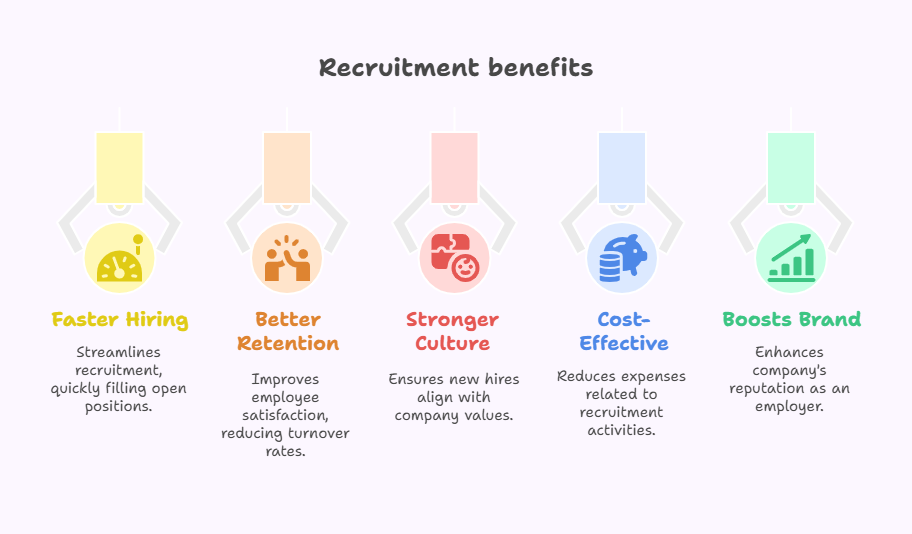
How to Build an Effective Employee Referral Program?
An employee referral program isn’t just a recruitment hack—it’s a business growth strategy, especially for fast-moving eCommerce brands. But to make it work, you need more than a generic idea and a cash reward. You need a thoughtful, well-structured program that aligns with your company culture and hiring needs.
Here’s a step-by-step roadmap to help you build a referral program that actually delivers results:
Step 1: Define Your Hiring Needs
Before rolling out the program, you need to get clear on where referrals will create the most value.
Start by identifying:
- High-turnover roles (e.g., warehouse pickers, customer service agents).
- Hard-to-fill positions (e.g., PPC specialists, eCommerce developers).
- Critical team gaps (e.g., fulfillment leads ahead of holiday season).
Pro Tip: Ask your department heads where they’ve seen the most hiring delays or highest turnover. That’s your starting point.
Example: If you’re scaling your online store and need reliable fulfillment staff for Q4, targeting referrals for warehouse roles makes more sense than generic office positions.
Step 2: Set Clear Guidelines
Your team won’t participate in the referral program if the rules are murky. Clarity = trust + higher engagement.
Your guidelines should cover:
- Who is eligible to refer? Most programs include all employees (except HR, hiring managers, and leadership for roles they oversee).
- Which roles are eligible? Be specific. List open positions and update this list regularly so employees know where they can help.
- What are the rewards and when are they paid out? For example: $300 when the referred candidate is hired, An extra $200 after 3 months of employment, Tiered bonuses for multiple successful referrals.
- What qualifies as a “successful referral”? Define this clearly. Does the person need to pass the interview? Stay employed for 60 days? Be a full-time hire?
- Sample Language: "You’ll receive a $500 bonus when your referral is hired and completes 90 days of employment. Part-time and contract roles are also eligible!"
Step 3: Offer Meaningful Incentives
Yes, money talks—but in eCommerce, you can get creative and tap into what your employees truly value.
Some incentive ideas include:
- Cash bonuses ($300–$1,000 depending on role and seniority).
- Employee-only discount codes (e.g., 40% off for 3 months).
- Early access to new products or sales.
- Loyalty program upgrades (e.g., Gold tier for a year).
- Extra PTO day or work-from-home voucher.
- Monthly “Top Referrer” award + swag.
For budget-conscious brands: Offer tiered incentives: $100 for a seasonal role, $500 for a senior hire, or even recognition shoutouts on Slack or internal newsletters.
Remember: Even small perks can drive big motivation if they feel personal and exclusive.
Step 4: Make It Super Easy to Use
Even the best program will flop if the process is a hassle.
Here’s how to streamline it:
- Use referral software like: Teamable, Zinc, Drafted.
- Create a simple form or internal portal where employees can submit referrals in under 2 minutes.
- Send automatic confirmation emails to both the referrer and the candidate.
- Track progress and update employees regularly on the status of their referral.
Example: “Submit a referral in Slack using /refer or click the link on the HR dashboard. Takes just 60 seconds!”
Bonus Tip: Add FAQs and examples to reduce confusion like: “Can I refer my cousin who applied last year but wasn’t hired?”
Step 5: Promote the Program Internally
If people don’t know about it, they won’t use it. You have to treat your referral program like a mini product launch.
Here’s how to create buzz:
- Email Announcements: Send company-wide emails when the program launches and whenever roles are added.
- Slack Reminders: Use a dedicated #referral channel or monthly nudges with job highlights.
- Team Meetings: Managers can give quick shoutouts or updates in team huddles.
- Visual Promos: Posters in the warehouse, digital signage in break rooms, or desktop wallpapers in offices.
- Leaderboard Gamification: Show top referrers and celebrate hires sourced through the program.
Pro Tip: Run “Referral Sprints”—time-bound campaigns where you double the bonus or add an extra perk if referrals are made within 2 weeks.
Example Campaign: “Refer a friend this month and get a $50 Amazon card on top of the bonus if they’re hired!”
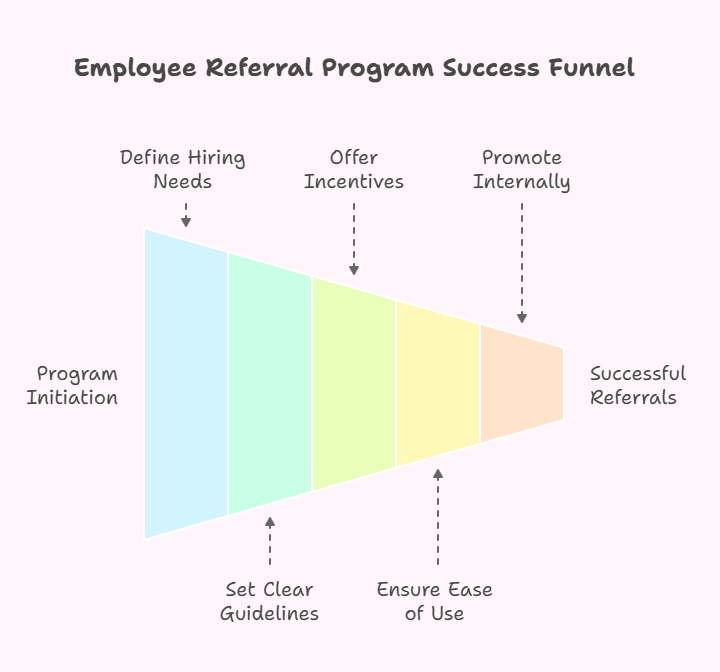
Best Practices for Running a Referral Program
Launching an employee referral program is one thing—keeping it running smoothly and effectively is another. To make sure your referral engine doesn’t stall after the initial excitement, you need a plan for tracking performance, keeping communication clear, and encouraging inclusive participation.
Here’s a closer look at the best practices every eCommerce brand should follow to maximize their referral program’s success:
- Track and Measure Referral Program Performance
You can’t improve what you don’t measure.
To understand if your program is working (and how to optimize it), track key metrics like:
- Number of referrals submitted.
- Referral-to-hire ratio.
- Time-to-hire for referred candidates.
- Retention rate of referred employees.
- Cost-per-hire via referral vs. other sources.
- Top referring employees or teams.
Use ATS (Applicant Tracking Systems) or referral software to automate and visualize this data. Popular tools include:
- Recruitee: Great for growing teams. Offers custom referral pipelines and built-in analytics.
- Workable: Offers built-in employee referral functionality, plus dashboards for tracking hiring performance.
- Teamtailor: Has branded referral portals and easy tracking for both HR and employees.
Pro Tip: Create a monthly or quarterly referral report. Share wins with leadership and highlight trends like “Best performing source this quarter: employee referrals!”
- Recognize and Reward Referrers Publicly
Public recognition goes a long way in building momentum. People want to feel appreciated—not just with a paycheck, but with genuine acknowledgment.
Here’s how to do it right:
- Shoutouts during team meetings or all-hands calls.
- Feature top referrers in internal newsletters or intranet.
- Celebrate in Slack channels (e.g., "Huge thanks to Priya in fulfillment for referring David—he’s joining our marketing team next week!").
- Small surprise perks like gift cards, lunches, or swag for consistent referrers.
Bonus Idea: Create a “Referral Rockstar of the Month” award with a small trophy or prize to keep the energy high.
Why it works: People love to be seen. A little recognition creates a ripple effect—more team members will start thinking about who they can refer next.
- Keep the Process Transparent
Referrers should never feel like their recommendation disappeared into a black hole. If they don’t hear back, they’re less likely to refer again.
Build transparency into every step:
- Confirmation Email: Let employees know their referral was received.
- Referral Status Updates: Keep them informed when the candidate is:
(a) Shortlisted
(b)Interviewed
(c)Rejected
(d)Hired
- Clear timelines: Let them know how long the review process typically takes.
- Create a referral FAQ or internal microsite with updates and guidelines.
Example update template: “Hey Sara, thanks again for referring Jake for the Customer Success role! He’s made it to the second round of interviews. We’ll keep you posted.”
Pro Tip: Assign someone from HR or People Ops to “own” referral communication and follow-ups.
- Incorporate Diversity & Inclusion Goals
Referral programs can unintentionally reinforce homogenous hiring—after all, people tend to refer others like themselves. But with intentional strategies, you can harness referrals while still promoting a diverse, inclusive team.
Here’s how:
- Educate employees on unconscious bias and the value of diversity.
- Encourage inclusive outreach: “Think beyond your inner circle—who do you know from previous roles, different backgrounds, or underrepresented communities who might be a great fit here?”
- Track diversity metrics of referred candidates (anonymously and ethically).
- Set diversity goals: e.g., “We’re aiming to improve representation on the engineering team—help us spread the word to more women in tech.”
- Sample messaging: “We value diverse experiences at [Brand Name]. When referring, think about people from different career paths, cultures, and communities who could bring something new to the table.”
Bonus Tip: Consider partnering your referral program with ERG (Employee Resource Groups) to boost outreach into new networks.
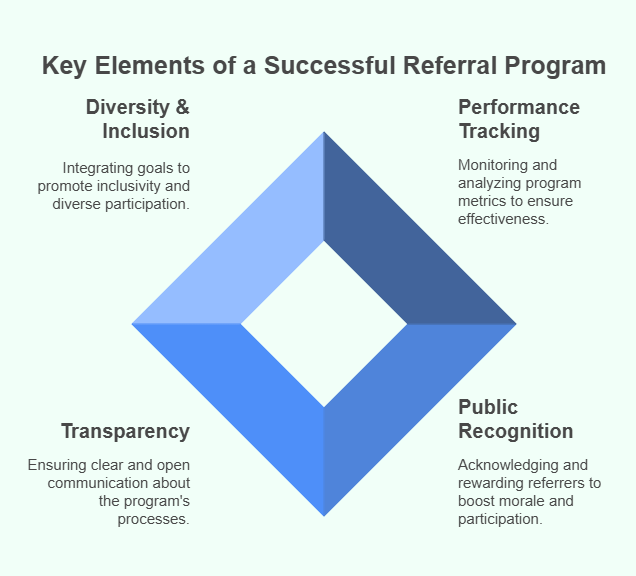
Employee Referral Rewards: What Works Best?
Let’s be honest — while many employees are happy to help grow the team, a little extra motivation never hurts. That’s where referral rewards come in. But here’s the thing: not all rewards are created equal. What excites your warehouse staff might not resonate with your marketing team.
The key? Offer flexible, thoughtful, and tiered incentives that show appreciation without breaking the bank.
Here’s a breakdown of popular and effective employee referral reward ideas — with examples and tips to implement them successfully in your eCommerce business:
- Cash Bonuses (Still the Most Reliable Incentive)
Cash remains the most universally appealing reward across industries. It’s simple, straightforward, and always valued.
How to do it well:
- Offer flat bonuses ranging from $250 to $2,000 depending on the role and level.
- Structure the payouts in phases:
(a)50% when the candidate is hired
(b)50% after they’ve stayed for 90 days (or a similar retention period)
Example: Refer a warehouse associate and receive a $500 bonus — $250 paid upon hiring and $250 after the new hire completes 90 days.
Pros:
- Immediate and flexible.
- Easy to administer through payroll.
Cons:
- May feel impersonal without additional recognition.
- Might not appeal to all employee demographics.
- Gift Cards, Extra Time Off, and Product Perks
Not each worker gets energized almost cash alone. Non-cash rewards can feel more individual and mindful, particularly in the event that they're custom fitted to your company's culture.
Examples include:
- Gift cards to popular retailers or restaurants.
- Bonus paid time off.
- Company-branded merchandise or free products.
- Experience-based rewards like dinner reservations or wellness services.
For eCommerce companies, you can make this even more relevant by offering early access to new product launches, employee-only bundles, or exclusive shopping credits. These types of rewards show appreciation in creative ways, while still motivating action.
- Tiered Incentives Based on Role Difficulty
Not all referrals are created equal. Referring an entry-level fulfillment team member is very different from sourcing a skilled developer or a senior supply chain manager. That’s why tiered incentives make sense — and can actually help fill high-priority roles faster.
A typical tier structure:
- Tier 1 (entry-level roles): $250–$500
- Tier 2 (mid-level or moderately competitive roles): $600–$1,000
- Tier 3 (high-demand, hard-to-fill roles): $1,500–$2,500+
- Tip: Clearly communicate the tier associated with each role when you share open positions internally.
For instance, you might say, “We’re hiring a logistics lead. Tier 3 referral bonus: $2,000.”
This approach lets employees know their referrals are valued according to their impact, not just volume.
- Loyalty-Based or Points-Based Rewards
If your company already uses a recognition platform, you can integrate your referral program into it and create a more gamified experience. This keeps engagement high, especially for ongoing hiring needs.
Ideas for loyalty-based systems:
- Award referral points for every valid submission, hire, or retention milestone.
- Allow points to be redeemed for merchandise, paid leave, or experiences.
- Offer tier-based recognition, where top referrers move up to premium status levels (like “Gold” or “VIP”).
- This structure is particularly effective for eCommerce teams used to working with loyalty programs, as it mirrors the type of rewards and engagement they’re already familiar with.
Helpful tools to explore:
(a)Bonusly
(b)Guusto
(c)Kazoo
Each of these allows for flexible, points-based recognition systems and can integrate with your internal communication tools.
- Departmental or Team-Based Referral Incentives
For bigger groups or regular enlisting spikes, it may be worth advertising group-based or departmental rewards. This cultivates collaboration and turns contracting into a collaborative exertion.
Examples: If a team refers three new hires in a quarter, reward the entire department with a catered lunch or experience day.
Run short-term contests: “Whichever department refers the most candidates by the end of the month wins a team reward”.
This strategy can boost referrals during peak periods (like holiday shopping season or major sale events), especially in operations or fulfillment departments that often need a staffing surge.
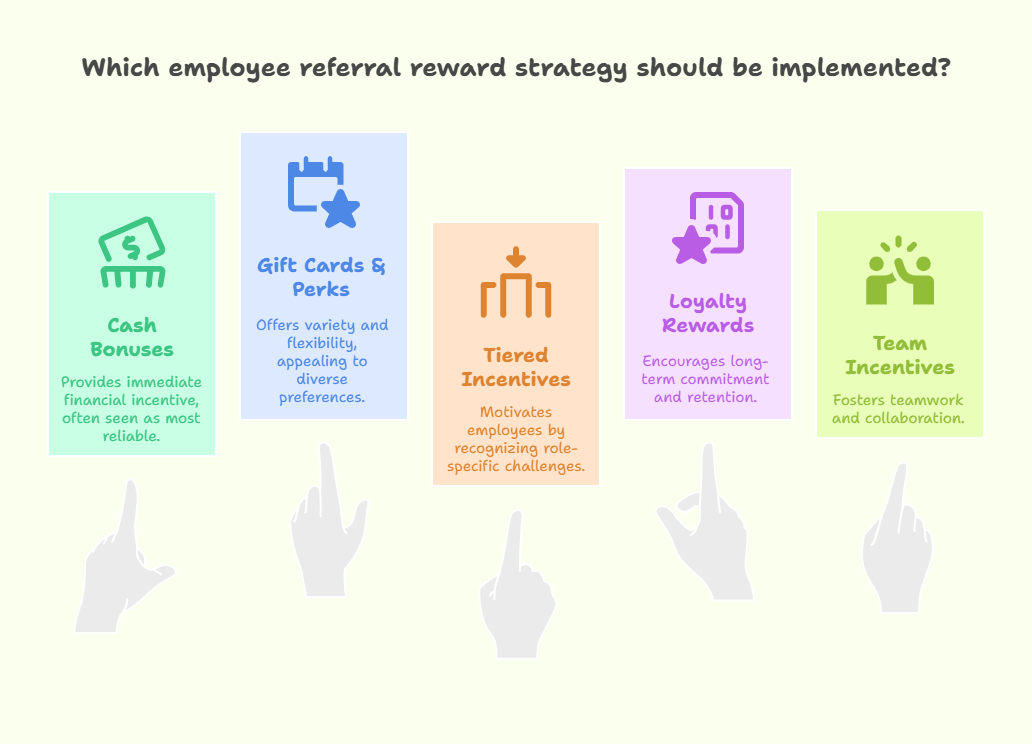
Integrating Referral Programs with Loyalty Strategy
In a fast-moving eCommerce environment, building dependability isn’t close to clients — it’s also approximately your workers. Once you coordinated your representative referral program into your broader dependability system, you make a steady culture of engagement and acknowledgment. This bound together approach moves forward both hiring outcomes and long-term maintenance.
Let’s break down how to put through the dabs between referrals and devotion in a way that genuinely works for eCommerce businesses.
- Offer Loyalty Points for Successful Referrals
Instead of (or in addition to) one-time bonuses, give employees loyalty points whenever their referral leads to a hire. These points can then be added to an internal rewards system — the same platform you might already be using for employee recognition or performance-based incentives.
Why it works:
- It creates an ongoing incentive loop instead of a one-time reward.
- Employees feel more invested in bringing in quality candidates, knowing their contribution builds toward bigger rewards over time.
- It aligns perfectly with the gamification principles many eCommerce brands already apply to customer loyalty programs.
Example:
- 100 points for a referral that’s interviewed.
- 300 points for a successful hire.
- 600 additional points after the new hire completes 90 days.
- Allow Employees to Redeem Points for Exclusive Merchandise or Perks
Motivate your team with rewards that are meaningful and aligned with your brand. Just like customer loyalty programs offer early product access or member-only perks, your employees should be able to use their points to access:
- Exclusive company merchandise.
- Gift cards or eWallet top-ups.
- Extra vacation days or early leave passes.
- VIP experiences (like product previews or warehouse tours).
- Lunch with leadership or internal shout-outs.
Pro Tip: If you have a DTC eCommerce brand, this is a great opportunity to showcase your own products as part of the rewards. It doubles as internal marketing and product engagement.
- Use a Loyalty Dashboard to Track Referral Program Performance
A dashboard or internal hub brings visibility, accountability, and excitement to your referral program.
Employees should be able to:
- Track how many people they’ve referred.
- See the current status of each referral (interview, hired, etc.)
- View their loyalty points balance and redemption history.
- Receive notifications when milestones are hit.
This transparency helps maintain trust and encourages continued participation. It also reduces HR follow-ups since employees can check everything themselves.
Tools to Consider:
- Bonusly: Coordinating acknowledgment, rewards, and referrals.
- Acclaim: Empowers peer-to-peer criticism and tracks engagement.
- Kazoo: Offers a full representative encounter stage with gamification and referral capabilities.
- Create a Unified Employee Experience
When referrals and loyalty are part of the same ecosystem, it promotes a culture of teamwork, contribution, and appreciation. It shows employees that their role in hiring matters just as much as their role in performance — and that both are rewarded in the same language: value and recognition.
Benefits of this integration:
- Better adoption and usage of both systems.
- Greater engagement with company values.
- Improved employee satisfaction and lower attrition rates.
- Increased referral volume over time.
Common Mistakes to Avoid
Even the best-planned referral program can fail if you fall into a few all-too-common traps. Below are mistakes eCommerce businesses should be especially mindful of — and how to steer clear of them.
- Offering Unclear or Delayed Rewards
The Problem: Employees lose interest quickly if they don’t know how the reward system works or if payouts are delayed for months with no communication.
Solution:
- Clearly outline the reward amount, eligibility criteria, and payment timeline.
- Consider breaking up payments (e.g., half upon hire, half after 90 days).
- Send automated updates when key stages are completed — like “Your referral was hired!” or “Your bonus is scheduled for this month.”
- Clarity and speed are everything when it comes to motivation.
- Failing to Promote the Program Internally
The Problem: Referral programs can’t succeed if no one knows about them. A one-time email announcement won’t cut it.
Solution:
- Keep the program top-of-mind with monthly internal newsletters.
- Pin it to your intranet or HR portal.
- Post open positions in Slack or Microsoft Teams regularly.
- Share success stories to inspire others.
- Promotion should be continuous — not just at launch.
- Ignoring Feedback from Employees
The Problem: Referral programs built in isolation often miss what employees actually want. If no one is participating or rewards are going unclaimed, something’s off.
Solution:
- Run quick pulse surveys to ask employees what types of incentives motivate them most.
- Get feedback from employees who’ve referred before — what worked? What didn’t?
- Be willing to test and evolve the program every few months.
- Listening helps refine your approach and drives higher adoption.
- Not Tracking Performance Metrics
The Problem: Without tracking results, it’s impossible to know if your referral program is effective — or where it needs tweaking.
Solution:
- Monitor these key referral metrics:
- Number of referrals submitted.
- Percentage of referrals hired.
- Time to hire (referrals vs. traditional candidates).
- Retention rate of referred employees.
- Referral participation rate across departments.
Use tools like Recruitee, Workable, or your ATS to collect and visualize this data. The insights you gather will help you fine-tune your strategy, identify top referrers, and justify continued investment in the program.
Conclusion
A well-designed employee referral program is more than a hiring tool — it’s a culture builder. For eCommerce merchants looking to scale sustainably, this strategy offers an effective way to attract loyal, high-performing talent while boosting team engagement and brand advocacy.
When combined with a smart loyalty program, referrals can evolve from just a hiring method to a powerful engine of growth.
Frequently-Ask-Questions-(FAQs)-on-Employee Referral Program
How do I launch an employee referral program if I’m a small eCommerce brand?
Start small. Create a simple system using Google Forms or Workable, set clear rules, and promote it in your internal channels.
How much should I offer for a referral bonus?
It depends on the role, but anywhere between $250–$1000 is common. Loyalty perks can be added to reduce upfront costs.
Can I integrate my employee referral program with my loyalty system?
Absolutely. Platforms like 99minds allow you to unify employee and customer incentives in one place.
What roles work best for referral hiring in eCommerce?
Customer service, fulfillment, marketing, and operations roles typically benefit most from referrals.
How do I track the performance of my referral program?
Use HR tools like Recruitee, Workable, or simple tracking dashboards. Monitor time-to-hire, retention, and referral source.






